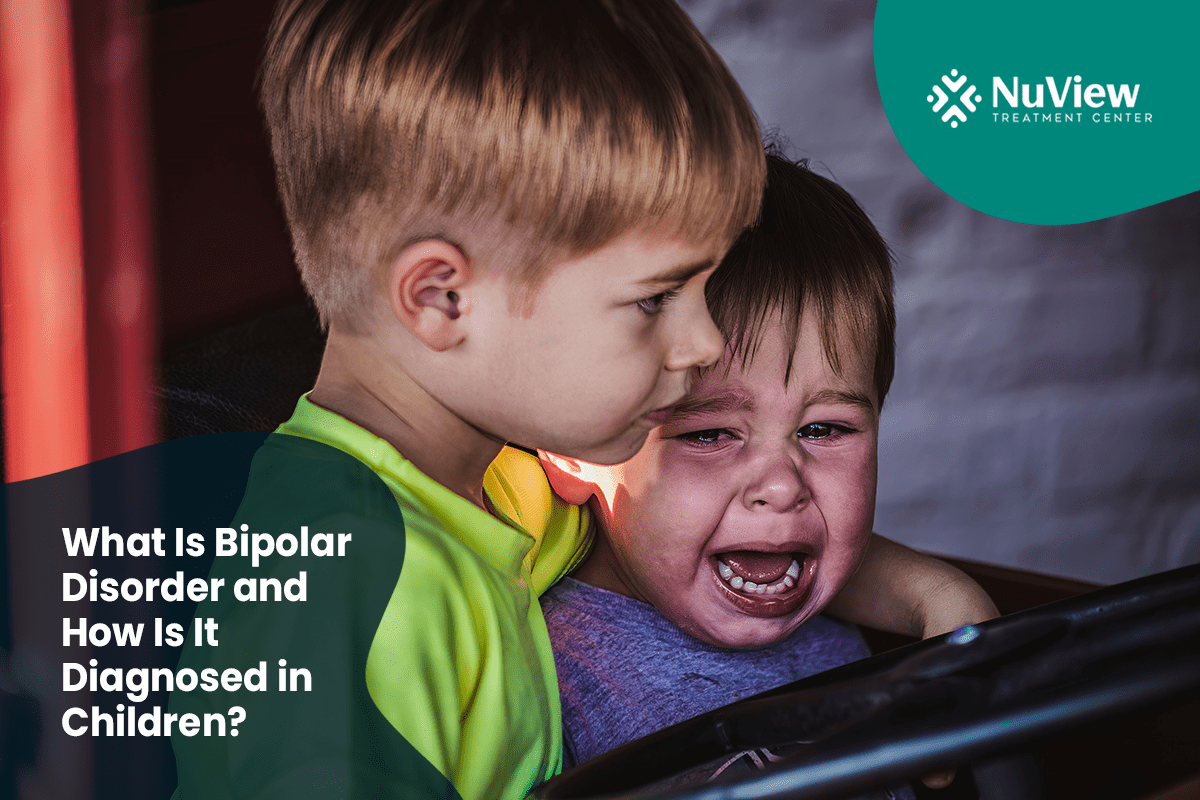Bipolar disorder is a mental health condition that causes significant changes in mood, energy, thinking, and behavior. It can affect people of any age, but it is often diagnosed in adolescence or adulthood. However, some children may show signs of bipolar disorder earlier in life.
Bipolar disorder is not the same as the usual ups and downs that every child goes through.
The mood changes in bipolar disorder are more extreme, often unprovoked, and interfere with daily functioning. Children with bipolar disorder may experience manic episodes, depressive episodes, or both.
Bipolar in children and teens can be challenging for the child and their family. However, with proper diagnosis and treatment, children with bipolar disorder can lead fulfilling and productive lives.
What Is Bipolar Disorder and How Is It Diagnosed in Children?
Bipolar disorder, formerly known as manic-depressive illness, is a mental health disorder that causes extreme changes in mood, energy, and behavior. People with bipolar disorder experience episodes of mania (highs) and depression (lows) that can last from days to months.
Bipolar disorder can affect anyone but often begins in late adolescence or early adulthood. However, some children and teens may also have bipolar disorder. According to the National Institute of Mental Health, about 2.9% of adolescents aged 13 to 18 have bipolar disorder.
Diagnosing bipolar disorder in children and teens can be challenging because their symptoms may differ from those of adults.
For example, younger children with bipolar disorder can have more chronic irritability, rapid mood changes, and mixed episodes (when manic and depressive symptoms co-occur).
Teens with bipolar disorder can have more severe manic or depressive symptoms, substance abuse, and suicidal thoughts.
To diagnose bipolar disorder in children and teens, health professionals use the same criteria as for adults, based on the Diagnostic and Statistical Manual of Mental Disorders (DSM-5).
What Criteria Are Used to Diagnose Bipolar Disorder in Children?
Diagnosing bipolar disorder in children is based on the Diagnostic and Statistical Manual of Mental Disorders (DSM-5) criteria, the standard reference for mental health professionals. According to the DSM-5, bipolar disorder can be classified into four types:
Bipolar I disorder
This type involves at least one mania or manic episode that lasts more than a week or requires hospitalization and may or may not be followed by a depressive episode.
A mania is a period of abnormally elevated, expansive, or irritable mood and increased energy or activity, accompanied by at least three of the following symptoms: inflated self-esteem, decreased need for sleep, more talkative than usual, racing thoughts, distractibility, increased goal-directed activity, or excessive involvement in risky behaviors.
Bipolar II disorder
This type involves at least one major depression episode that lasts for at least two weeks and at least one hypomanic episode that lasts for at least four days but does not meet the criteria for mania. A hypomanic episode is similar to a mania but less severe and does not cause significant impairment in functioning or require hospitalization.
Cyclothymic disorder
This type involves multiple periods of hypomanic and depressive symptoms that do not meet the criteria for a full-blown episode, lasting at least two years in adults or one year in children and adolescents.
Other specified bipolar and related disorders
This type applies to cases that do not fit into the other categories but cause significant distress or impairment.
Did you know that children with bipolar disorder can experience seasonal patterns in their mania and depression, with symptoms worsening in certain seasons? These seasonal patterns can complicate diagnosis and treatment, as symptom severity may vary throughout the year.
How Does Diagnosis Differ in Children Compared to Adults?
Diagnosing bipolar disorder in children and teens can be more complex than in adults for several reasons:
The child's symptoms may overlap with other mental health conditions common in children and adolescents, such as attention deficit hyperactivity disorder (ADHD), oppositional defiant disorder (ODD), anxiety disorders, or major depressive disorder.
The child's symptoms may vary depending on the age and developmental stage of the child or teen. For example, younger children may experience more chronic irritability and tantrums, while older children and teens may experience more distinct episodes of mania and depression.
The child's symptoms may change over time as the child or teen grows and matures. For example, some children may initially have symptoms of disruptive mood dysregulation disorder (DMDD), characterized by persistent and severe irritability and anger outbursts, and later develop signs and symptoms of bipolar.
Environmental factors, such as stress, trauma, family conflict, substance use, or hormonal changes, may influence bipolar disorder symptoms in children.
Unlike adults, children may not have the vocabulary or self-awareness to describe their mood swings accurately. Therefore, the diagnosis process heavily depends on gathering information from multiple sources, including parents, teachers, and sometimes even the child's peers.

Bipolar Disorder Symptoms in Children?
Some of the bipolar disorder symptoms in children and teens may include:
Severe mood swings that last from a few hours to a few days. These mood swings may range from happy, excited, or irritable (mania) to sad, hopeless, or angry (depression).
Changes in sleep patterns include sleeping too much or too little or having trouble falling or staying asleep.
Changes in appetite include eating too much or too little or having cravings for certain foods.
Changes in activity level, such as being very energetic and restless (mania) or very tired and sluggish (depression).
Changes in thinking and behavior include racing thoughts, talking very fast (mania), or having trouble concentrating or making decisions (depression).
Engaging in risky or impulsive behaviors, such as wasting money, driving dangerously, or using drugs or alcohol (mania).
Having low self-esteem or feeling worthless or guilty (depression).
Having thoughts of death or suicide, or attempting suicide (depression).
What Does a Manic Episode Look Like in Children?
Manic symptoms in children are akin to emotional roller coasters. During a manic episode, a child with bipolar disorder may exhibit the following behaviors:
Increased Energy: Children become hyperactive, displaying a surplus of energy that may make them appear restless.
Decreased Need for Sleep: They may sleep less than usual, feeling refreshed after only a few hours.
Heightened Self-Esteem: Children may have an inflated sense of self-importance and may boast about their abilities and achievements.
Impulsivity: During manic episodes, children may act impulsively, engaging in risky behaviors without considering the consequences.
How Do Depressive Episodes Manifest in Children?
Conversely, depressive episodes in children manifest with the following characteristics:
Sadness and Hopelessness: Children may express intense sadness and hopelessness. They might cry frequently and have difficulty finding joy in activities they once enjoyed.
Changes in Appetite: Depressive episodes can lead to changes in appetite, resulting in either overeating or undereating.
Sleep Disturbances: Children with bipolar disorder may experience changes in their sleep patterns, including difficulty falling asleep or oversleeping.
Loss of Interest: They may lose interest in activities, isolate themselves, and struggle to engage with friends and family.
How Does Bipolar Disorder Affect a Child's Daily Life and Development?
Bipolar disorder can significantly affect a child's daily life and overall development, including academic performance and social relationships.
The mood swings and other symptoms of bipolar disorder can profoundly impact a child's ability to perform well in school, leading to social difficulties and peer isolation.
What Impact Does Bipolar Disorder Have on Academic Performance?
Children with bipolar disorder may experience difficulties in school due to their mood swings and other symptoms. These challenges can include:
Inconsistent Performance: Bipolar disorder can lead to inconsistent academic performance. During manic phases, children may excel in some areas, demonstrating high energy and creative thinking. However, during depressive phases, they might struggle to concentrate and complete assignments.
Attendance Issues: During depressive episodes, children may find it extremely difficult to get out of bed and attend school regularly. Conversely, during manic phases, their behavior may become disruptive in the classroom, affecting their ability to focus and learn.
Social Isolation: The mood swings and irritability associated with bipolar disorder can lead to social difficulties and peer isolation. Friends may have difficulty understanding and coping with the child's unpredictable behavior, which can lead to conflicts and strained relationships.
How Does Bipolar Disorder Affect Social Interactions and Relationships?
Children with bipolar disorder may find establishing and maintaining healthy social interactions and relationships challenging. They may encounter the following issues:
Conflict with Peers: The irritability and impulsivity during manic episodes can lead to peer conflicts. When a child has bipolar disorder, they might have difficulty regulating their emotions and actions, which can result in arguments and strained friendships.
Strained Family Relationships: The mood swings can also strain family relationships, as parents and siblings may struggle to understand and cope with the child's condition.
Friendship Challenges: Maintaining friendships can be difficult for children with bipolar disorder. Their behavior can be unpredictable, making it challenging for peers to relate and connect with them.

What Treatment Options Are Available for Children with Bipolar Disorder?
Treatment typically involves a combination of medication and therapy. Here are some key components of treatment:
Medication
Medications are often prescribed to manage the symptoms of bipolar disorder in children. Mood stabilizers, such as lithium, and atypical antipsychotic medications, like aripiprazole or quetiapine, are commonly used.
These medications help regulate mood and reduce the severity of manic and depressive episodes.
Therapy
Various types of therapy can benefit children and teens with bipolar disorder. Cognitive-behavioral therapy (CBT) is one approach that helps children understand their emotions and develop coping strategies.
Family-focused therapy involves the child and their family, helping them communicate effectively and manage the challenges of bipolar disorder as a team.
Psychoeducation is another crucial aspect of therapy, educating the child and their family about the condition and its management.
Are There Age-Appropriate Medications and Therapies?
The treatment of pediatric bipolar disorder may involve age-appropriate medications and therapies. Medications, including mood stabilizers and antipsychotics, may be prescribed based on the child's specific symptoms and needs.
Therapies, such as cognitive-behavioral therapy (CBT) and family-focused therapy, are often used to help children and their families understand and manage the condition. These therapies can teach coping strategies and communication skills.
Did you know that creative arts therapies, such as music or art therapy, can be effective in helping children with bipolar disorder express their emotions and improve their well-being? Engaging in creative activities can provide an outlet for their emotions and improve their overall mental health.
What Role Do Parents and Caregivers Play in Treatment?
Parents and caregivers play a crucial role in treating children with bipolar disorder. Their involvement includes:
Observation: Parents and caregivers often first notice changes in the child's behavior and mood. Sharing these observations with a qualified mental health professional aids diagnosis and treatment planning.
Medication Management: Parents must ensure that the child takes medication as prescribed and report any side effects or concerns to the treating healthcare provider.
Emotional Support: Providing a supportive and understanding environment is essential. A child diagnosed with bipolar disorder may need extra emotional support for their mood disorder and treatment.
How Does Bipolar Disorder Co-Exist with Other Conditions in Children?
Bipolar disorder can co-exist with other conditions in children, such as anxiety, attention-deficit/hyperactivity disorder (ADHD), disruptive mood dysregulation disorder (DMDD), and substance use disorders.
These co-occurring conditions can make it harder to diagnose and treat bipolar disorder in teens and children.
Are Children With Bipolar Disorder More Likely to Have Other Behavioral or Mental Health Issues?
Yes, children with bipolar disorder are more likely to have comorbid conditions. Some of the commonly co-occurring conditions in children with bipolar disorder include:
Attention Deficit Hyperactivity Disorder (ADHD): ADHD is characterized by symptoms such as impulsivity, hyperactivity, and difficulties with attention and focus. Both conditions can result in increased emotional and behavioral challenges for the child.
Oppositional Defiant Disorder (ODD): ODD is a behavioral disorder characterized by a pattern of hostile and defiant behavior. Children with ODD may have trouble complying with rules and authority figures, leading to frequent conflicts at home and school.
Anxiety Disorders: These disorders can manifest as excessive worry, fear, and avoidance behaviors. When combined with bipolar disorder, the child may experience intensified mood swings and cognitive challenges.
How Do Comorbid Conditions Affect Treatment and Management?
When a child has comorbid conditions alongside bipolar disorder, treatment can become more complex. Healthcare providers must tailor their approach to addressing all a child's and adolescent's unique needs.
In cases of comorbidity, a comprehensive assessment is crucial to determine the full scope of the child's mental health challenges. This assessment can involve input from various healthcare providers, including psychiatrists, psychologists, and social workers.
The treatment plan must address bipolar disorder and the co-occurring conditions, often requiring a multidisciplinary approach.
What Role Do Genetics and Family History Play in Teen Bipolar Disorder?
One of the factors that may influence the development of bipolar disorder is genetics. Bipolar disorder tends to run in families, and research has identified several genes that may increase the risk of developing this condition.
However, genetics alone cannot explain why some people develop mood disorders, and others do not. Environmental factors, such as stress, trauma, substance abuse, and hormonal changes, may also play a role in triggering or worsening the symptoms of bipolar disorder.
Are Children with a Family History More Likely to Develop Bipolar Disorder?
One factor that may affect the onset and course of bipolar disorder is family history. A parent or sibling with bipolar disorder increases the likelihood of developing this condition by about 10 times.
However, not everyone who has a family member with bipolar disorder will develop it themselves. Conversely, some people with no family history of bipolar disorder may still develop it.
Family history can also influence the age of onset, severity, and type of bipolar affective disorder. For example, early onset bipolar disorder, which occurs before age 18, is more common among people with a parent diagnosed with bipolar disorder.
How Do Genetic Factors Interact with Environmental Triggers?
While genetics contribute to the risk of bipolar disorder, environmental factors can also trigger the condition or influence its severity. These factors may include:
Stress: High stress levels can trigger mood swings in individuals with a genetic predisposition to bipolar disorder. This stress can be related to various life events, such as work or school pressures, relationship difficulties, or traumatic experiences.
Trauma: Traumatic events, especially during childhood, can increase the risk of developing bipolar disorder or exacerbate existing symptoms. Childhood trauma, such as physical, emotional, or sexual abuse, can profoundly impact mental health.
Substance Abuse: Substance abuse, including alcohol and drug use, can worsen the symptoms of bipolar disorder. It can also trigger mood swings and impulsive behavior, which can complicate the management of the condition.
Did you know that proper sleep patterns can significantly impact the mood stability of children with bipolar disorder Establishing and maintaining healthy sleep routines is crucial in managing bipolar symptoms in children, as sleep disturbances can trigger mood swings.
Ready to Provide Compassionate Care for Your Child's Mental Health Journey?
At NuView Treatment Center, we understand the complexities of bipolar disorder. Our dedicated team specializes in compassionate dual diagnosis treatment, addressing mental health challenges and co-occurring conditions.
If your child is showing signs of bipolar disorder, we're here to support them on their path to recovery.
Contact NuView Treatment Center today to schedule a consultation.
Source
“Bipolar Disorder.” National Institute of Mental Health (NIMH), www.nimh.nih.gov/health/statistics/bipolar-disorder.
“Bipolar Disorder in Children and Teens.” National Institute of Mental Health (NIMH), www.nimh.nih.gov/health/publications/bipolar-disorder-in-children-and-teens.
Bosgraaf, Liesbeth, et al. “Art Therapy for Psychosocial Problems in Children and Adolescents: A Systematic Narrative Review on Art Therapeutic Means and Forms of Expression, Therapist Behavior, and Supposed Mechanisms of Change.”Frontiers in Psychology, vol. 11, 2020, https://doi.org/10.3389/fpsyg.2020.584685. Accessed 15 Oct. 2023.
Comsa, Monica, et al. “The Relationship between Sleep and Depression and Bipolar Disorder in Children and Young People.”BJPsych Open, vol. 8, no. 1, 2021, https://doi.org/10.1192/bjo.2021.1076. Accessed 15 Oct. 2023.
Escamilla, Michael A., and Juan M. Zavala. “Genetics of Bipolar Disorder.”Dialogues in Clinical Neuroscience, vol. 10, no. 2, 2008, pp. 141-152, https://doi.org/10.31887/DCNS.2008.10.2/maescamilla. Accessed 15 Oct. 2023.
Geoffroy, Pierre A., et al. “Bipolar Disorder with Seasonal Pattern: Clinical Characteristics and Gender Influences.”Chronobiology International, vol. 30, no. 9, 2013, pp. 1101-1107, https://doi.org/10.3109/07420528.2013.800091. Accessed 15 Oct. 2023.
Substance Abuse and Mental Health Services Administration. DSM-5 Changes: Implications for Child Serious Emotional Disturbance [Internet]. Rockville (MD): Substance Abuse and Mental Health Services Administration (US); 2016 Jun. 3, DSM-5 Child Mental Disorder Classification. Available from: https://www.ncbi.nlm.nih.gov/books/NBK519712/
Popular Searches:Am I Bipolar | Schizoaffective Bipolar Disorder | Is Bipolar Hereditary | Bipolar Disorder With Psychotic Features | Does Bipolar Get Better With Age | ICD 10 Code For Bipolar Disorder | Bipolar II Disorder | Bipolar Disorder Test | Bipolar Disorder 1 | Famous People With Bipolar Disorder | Mixed Episode Bipolar | Bipolar 1 vs Bipolar 2 | Bipolar Disorder Causes | Bipolar Symptoms In Women | What Is Bipolar Mania | How A Bipolar Person Loves | Lithium Bipolar Medication






